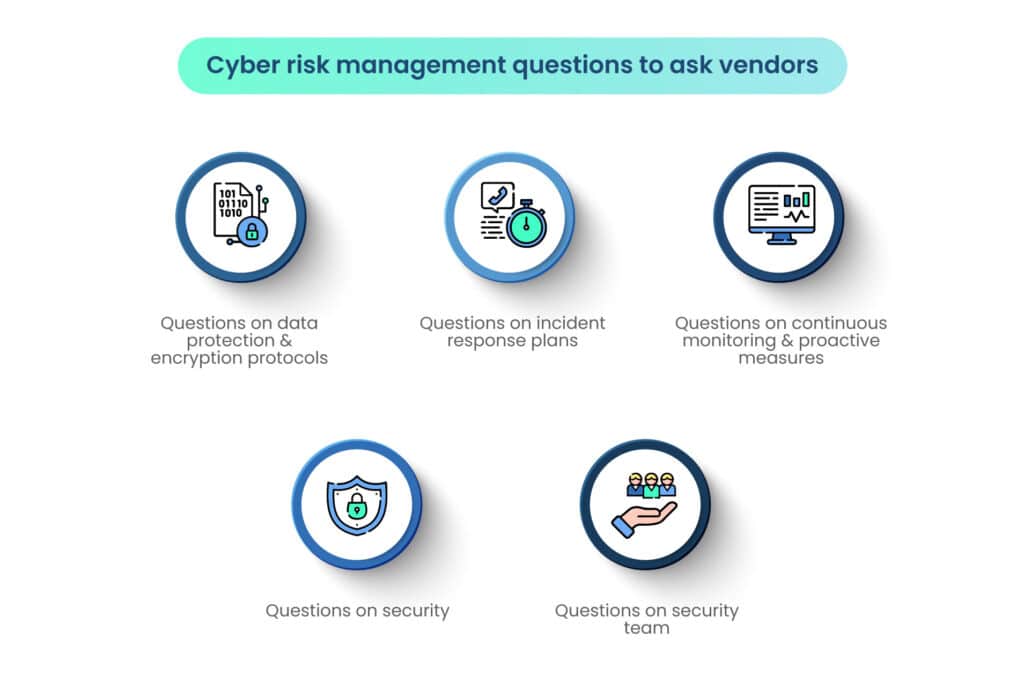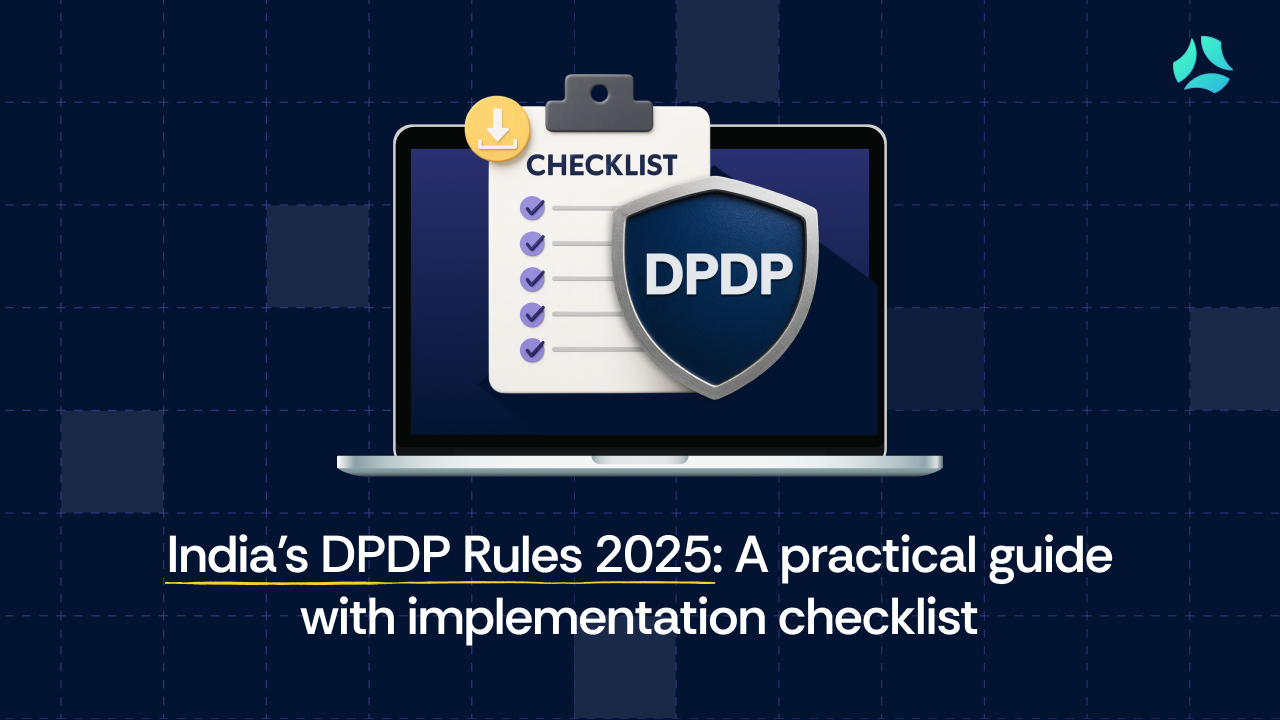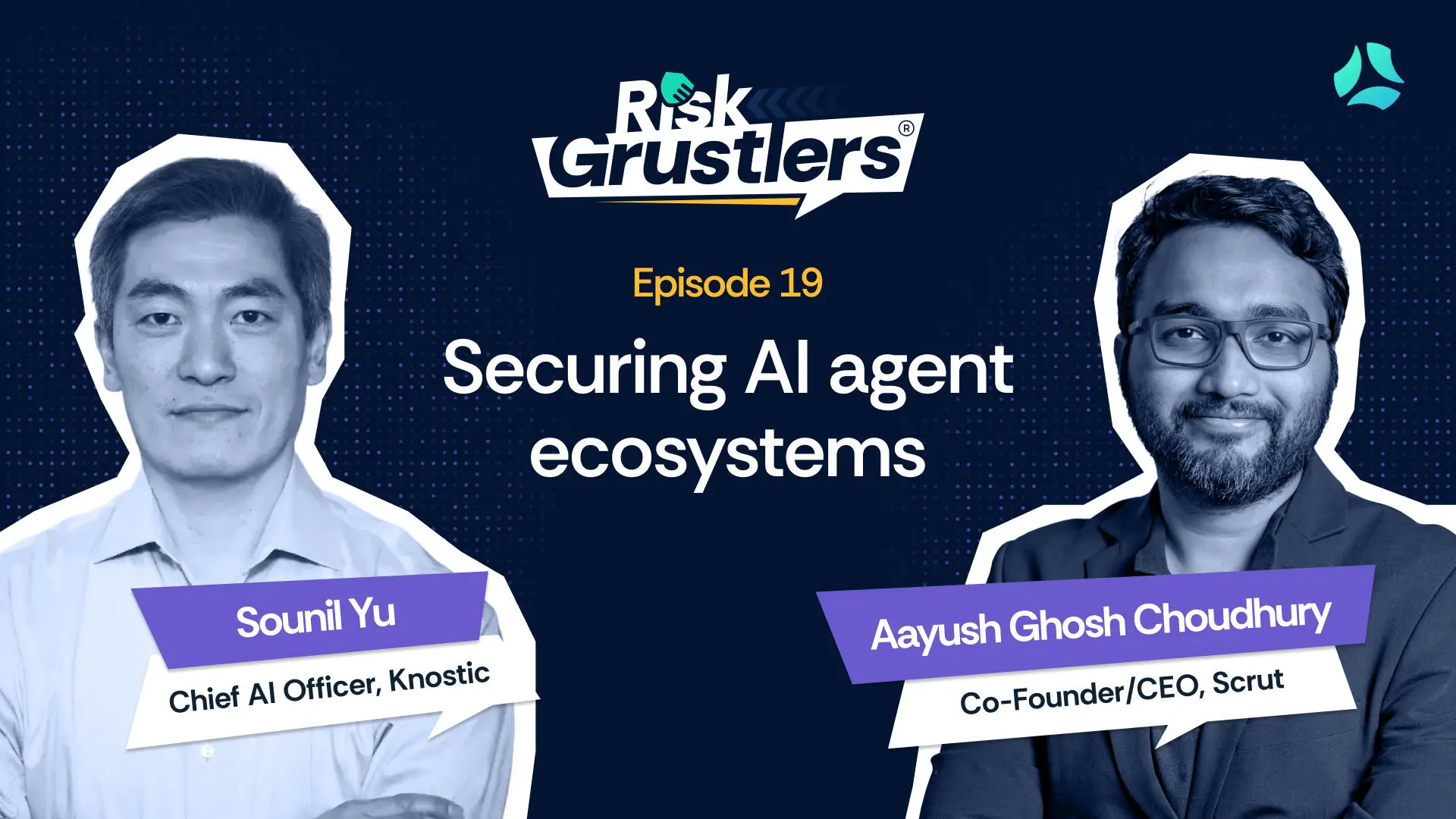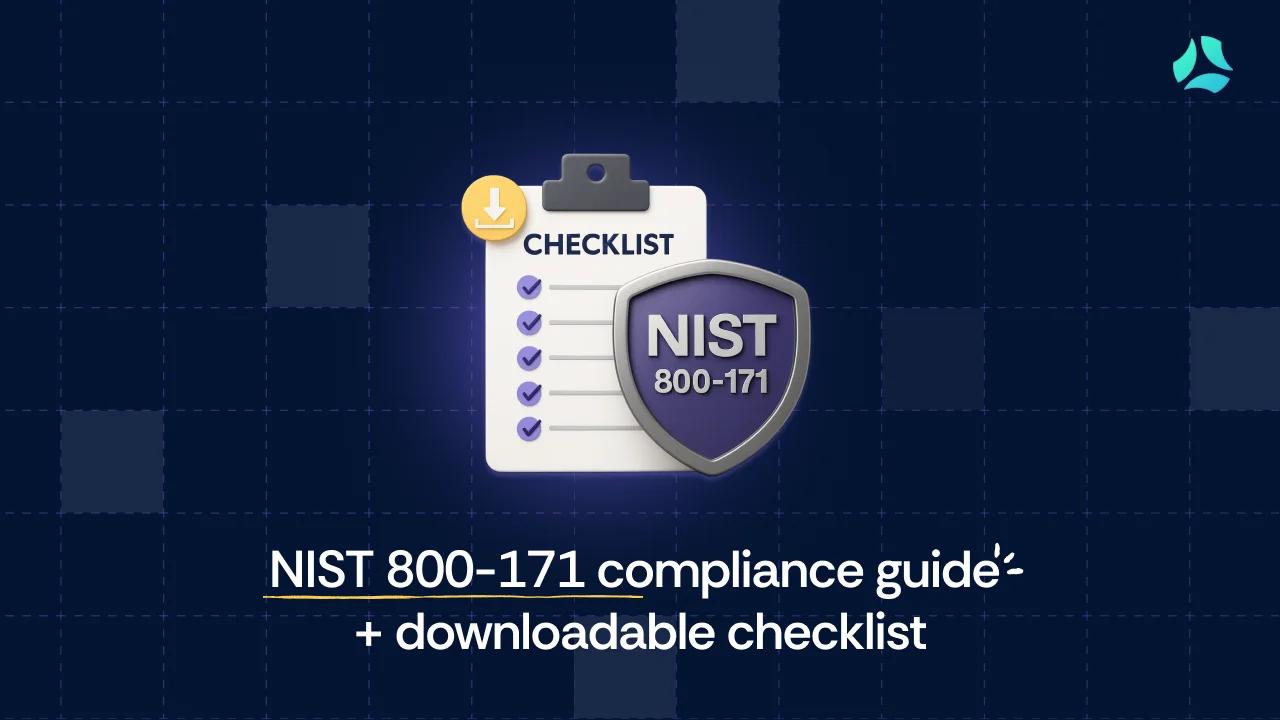Vendor cybersecurity inquiry: Essential questions for risk management

In the complex tapestry of today’s digital age, as businesses increasingly rely on external vendors for specialized services, the intricacies of cyber security risk management become more pronounced.
Amidst these technological advancements, organizations are confronted with an intricate web of cyber threats and potential vulnerabilities and risks associated with third-party collaborations, ranging from data breaches to malicious cyber attacks.
The solution lies in meticulous vendor assessment underpinned by cyber security and risk management strategies specific to vendor relationships. These strategies encompass stringent vendor assessments, continuous monitoring, and clear protocols for incident response.
By intricately examining the cyber security posture of vendors and asking them the right questions, organizations can pinpoint potential weaknesses and enforce stringent security measures. This approach not only mitigates risks but also fosters a culture of shared responsibility between organizations and their vendors.
Collaboration and communication
Cybersecurity is a collective responsibility that extends beyond organizational boundaries. The concept of collaborative security is emphasized, encouraging active cooperation between organizations and their vendors.
Collaboration extends beyond the transactional to the foundational alignment of cybersecurity standards. By fostering a culture of collaborative security, organizations and vendors can work together to fortify defenses and create a unified front against cyber threats.
In a collaborative security framework, both parties work together to strengthen their defenses. This involves joint training initiatives, sharing relevant threat intelligence, and providing mutual support.
Clear and open channels of communication establish a foundation of understanding between organizations and their vendors. This transparency not only facilitates a shared commitment to cybersecurity but also allows for the open discussion of potential risks.
By fostering an environment of openness and shared responsibility, organizations and vendors can collectively address and mitigate cybersecurity challenges.
Assessing vendor security posture: Key cyber risk management questions to ask vendors

Effective cyber risk management begins with a thorough assessment of a vendor’s cybersecurity measures. The goal is to discern whether a vendor aligns with the organization’s cyber risk management standards and practices.
Understanding the nuances of cyber risk management involves crafting incisive questions that delve into the heart of an organization’s cybersecurity posture.
The challenge lies in formulating questions that go beyond surface-level inquiries and delve into the intricacies of a vendor’s cybersecurity practices.
Crafting effective questions can help organizations unearth crucial insights, uncover vulnerabilities and strengths within their vendor relationships, ensuring a thorough assessment of potential risks.
Here is a brief overview of questions that you can ask vendors on various aspects of cybersecurity risk management:
Questions on data protection and encryption protocols
The cornerstone of data protection is encryption protocols, which function as a fundamental safeguard for sensitive information. Encryption involves transforming data into a coded format, decipherable only with the appropriate decryption key. This process serves as a crucial defense mechanism against unauthorized access, creating a secure layer that shields sensitive information from exploitation by malicious actors.
Sensitive data, such as personally identifiable information (PII), financial records, and proprietary business information, necessitates special protection. Robust encryption methods guarantee that even if unauthorized parties gain access to the data, they cannot decipher its meaning without the proper cryptographic keys. This security applies to both data storage within databases and systems and its transmission across networks.
To ensure the efficacy of data security measures, organizations should examine vendors’ encryption practices. This involves understanding the encryption algorithms used, key management processes, and the strength of the encryption keys. Proactively assessing these aspects helps identify and address potential weaknesses, thereby reducing the risk of unauthorized access to sensitive data and potential data breaches.
Many data protection regulations and standards mandate the use of encryption to safeguard sensitive information. Ensuring vendors comply with these regulations not only helps organizations avoid legal penalties but also demonstrates a commitment to data security best practices.
Questions to Vendor:
- Can you outline your data access policies and controls?
- What protocols are in place to safeguard against unauthorized data access?
- Can you explain the encryption methods you employ to safeguard sensitive information?
- Why is encryption considered a fundamental part of your data protection strategy?
- How do you ensure the use of robust encryption methods to secure sensitive data?
- Can you provide examples of the types of sensitive information that receive special protection?
- In what ways does your encryption strategy serve a dual role in securing data both during storage and transmission, and how does it contribute to end-to-end security?How does your organization encrypt sensitive data during transmission and storage?
- Can you provide details about your encryption practices, including the encryption algorithms you use, your key management processes, and the strength of your encryption keys?
- How does your encryption strategy contribute to mitigating the risk of unauthorized access to sensitive data, and in what ways does it proactively identify and address potential weaknesses?
- In your view, how does robust encryption serve as a deterrent for preventing data breaches, and how does it make it more challenging for unauthorized entities to exploit stolen data?
- How do you ensure compliance with data protection regulations that mandate the use of encryption, and can you describe the measures in place to meet these regulatory requirements?
Questions on incident response plans
The ability to respond swiftly to cybersecurity incidents is paramount. A well-defined and practiced incident response plan demonstrates a vendor’s commitment to minimizing the impact of cyber threats. Effective incident response not only aids in mitigating risks but also contributes to maintaining operational continuity.
Understanding the overall framework and organization of the incident response plan is crucial for assessing its effectiveness. Regular testing and updates ensure that the plan remains relevant and can effectively address evolving cybersecurity threats.
Ensuring that the incident response plan comprehensively addresses various types of cyber threats is essential for a robust defense mechanism. Clear procedures for identifying and categorizing incidents are fundamental for a swift and accurate response to potential threats.
Understanding the designated roles and responsibilities helps gauge the level of coordination and expertise in handling different aspects of incident response. Effective internal communication is crucial for a coordinated response, and understanding the communication channels and protocols is key.
Preserving evidence is vital for subsequent investigations, and having established measures ensures the integrity of the incident response process.
Transparent communication with external parties is important, and the incident response plan should outline protocols for managing external relations during an incident. Assessing the technological infrastructure supporting incident response provides insights into the efficiency and effectiveness of the overall response process.
Learning from past incidents and understanding the practical application of the response plan helps evaluate its real-world effectiveness. A commitment to continuous improvement ensures that the incident response plan evolves in line with emerging threats and lessons learned from previous incidents.
Keeping the incident response plan up-to-date requires staying informed about the latest threats, vulnerabilities, and best practices in cybersecurity.
These questions investigate the presence and effectiveness of a vendor’s incident response plans.
Questions to vendors
- What is the structure of your incident response plan?
- How frequently is your incident response plan tested and updated?
- What specific types of cyber threats does your incident response plan cover?
- Can you describe the procedures for identifying and categorizing a cybersecurity incident?
- What roles and responsibilities are defined within your incident response team?
- How do you communicate internally during a cybersecurity incident?
- What measures are in place for preserving evidence during an incident?
- How does your incident response plan address communication with external stakeholders, such as customers and regulatory bodies?
- What tools and technologies are integrated into your incident response capabilities?
- Can you provide examples of past incidents and how your response plan was implemented?
- What measures are in place to continuously improve the incident response process?
- How do you stay informed about the latest cybersecurity threats and incorporate this information into your incident response plan?
Questions on continuous monitoring and proactive measures
In the ever-evolving landscape of cyber threats, continuous monitoring is a proactive measure to detect and address potential risks. By consistently assessing their systems for vulnerabilities and anomalies, vendors contribute to the ongoing resilience of the organizations they serve.
The focus of the questions below is on understanding the capabilities of vendors in delivering effective continuous monitoring solutions. From integration with existing systems to scalability considerations and the fostering of a cybersecurity-aware culture, these questions aim to empower organizations to make informed decisions when selecting vendors, fortifying their cybersecurity posture in the face of relentless cyber threats.
- How does your product/service facilitate continuous monitoring for potential vulnerabilities and anomalies in real time?
- Can you provide examples of how your solution adapts to the evolving landscape of cyber threats?
- How quickly does your solution detect and respond to potential cyber threats? Can you share any success stories or case studies demonstrating its effectiveness in real-world scenarios?
- How easily can your continuous monitoring solution be integrated into our existing cybersecurity framework?
- What considerations should we take into account during the integration process to ensure a seamless implementation?
- How scalable is your solution, especially for organizations experiencing growth or changes in their IT infrastructure?
- What resources are required for maintaining and optimizing continuous monitoring over time?
- How does your solution ensure compliance with industry regulations and standards related to cybersecurity?
- Can you provide insights into how your continuous monitoring aligns with specific regulatory requirements in our industry?
- Does your solution include features that promote a culture of cybersecurity awareness among our employees?
- How can your product empower our staff to actively contribute to a more secure environment?
- In what ways does your solution go beyond reactive measures and incorporate proactive elements to anticipate potential threats?
- Can you explain how your product utilizes predictive analysis to identify emerging cybersecurity risks?
- What kind of reporting and analytics does your solution provide to help us understand the effectiveness of our continuous monitoring efforts?
- How customizable are these reports, and can they be tailored to meet specific organizational needs?
- How does your solution foster collaboration with other security tools or vendors in our ecosystem?
- Can you provide examples of successful collaborations your product has had with other security solutions?
- What training and support services do you offer to ensure our team is proficient in utilizing your continuous monitoring solution?
- How responsive is your support team in addressing issues and providing timely assistance?
Questions on security
As businesses increasingly rely on external partners and technologies, it becomes imperative to scrutinize the security measures implemented by vendors.
The following set of questions is designed to delve into the strategies and practices employed by vendors to evaluate and ensure the security of their systems, prioritize security in software development, and fortify network security protocols.
By posing these questions, organizations can make informed decisions, ensuring that their collaborators meet stringent security standards and contribute effectively to a robust cybersecurity ecosystem.
- Elaborate on the methods and processes your organization employs to continuously evaluate and ensure the security of its systems.
- How frequently are security audits conducted, and what measures are in place to address vulnerabilities promptly?
- Provide insights into the security practices integrated into your organization’s software development lifecycle to enhance overall system security.
- How does your organization prioritize and address security concerns during the various stages of software development?
- Could you detail the network security protocols implemented by your organization to safeguard against potential cyber threats?
- How does your approach to network security adapt to emerging threats and technological advancements?
Questions on security team
A vigilant and proficient security team is the bedrock of a resilient cybersecurity infrastructure. When engaging with vendors, understanding the capabilities of their security teams becomes paramount.
The following questions aim to shed light on the competence of the security team in handling potential cyber threats, the effectiveness of their incident response mechanisms, and the measures in place for continuous improvement.
Additionally, insights into the training and awareness programs for employees regarding cybersecurity help assess the vendor’s commitment to maintaining a proactive and secure working environment.
These questions collectively provide a comprehensive view of the vendor’s security team, ensuring alignment with the organization’s security expectations and standards.
- How competent is your security team in proactively identifying and handling potential cyber threats?
- Can you provide examples of successful incidents where your team effectively mitigated security risks?
- Share details about the proficiency and effectiveness of your incident response team. How quickly can your team respond to and contain a security incident?
- What measures are in place to continuously improve the capabilities of your incident response team?
- What training and awareness programs are in place for your employees regarding cybersecurity?
- How does your organization ensure that employees stay informed about evolving cyber threats and best practices for maintaining a secure work environment?
Wrapping up
Safeguarding against cyber threats requires a multifaceted and proactive approach.
The fundamental principles that underscore effective cyber risk management include transparent communication, collaborative security efforts, proactive measures against emerging threats, and the importance of a robust incident response and business continuity plan.
Looking toward the future, organizations must remain vigilant and proactive in the face of evolving cyber threats. The road ahead involves continuous adaptation to emerging risks, regular assessments of cybersecurity measures, and the integration of lessons learned from past incidents.
A cyber-risk management platform, like Scrut, can help you find a resilient and adaptive approach to safeguard against the dynamic nature of cyber threats. Schedule a demo today to find out more!
Frequently Asked Questions
1. What is cyber risk management, and why is it important for businesses?
Cyber risk management involves identifying, assessing, and mitigating potential threats to an organization’s digital assets. Businesses must protect sensitive data, maintain operational resilience, and safeguard against financial and reputational damage.
2. How can organizations effectively assess and mitigate cyber risks in their vendor relationships?
Organizations can assess and mitigate cyber risks in vendor relationships by thoroughly vetting vendors’ cybersecurity measures, conducting regular risk assessments, and ensuring contractual agreements include stringent security provisions.
3. What key cybersecurity measures should vendors have in place to ensure data protection and secure business operations?
Vendors should implement robust encryption methods, have secure data storage and transmission protocols, enforce secure software development practices, and conduct regular cybersecurity training for employees.
4. How frequently should organizations conduct cybersecurity assessments and update their risk management strategies?
Cybersecurity assessments should be conducted regularly, at least annually or whenever there are significant changes to the organization’s infrastructure. Risk management strategies should be continuously updated to address emerging threats.
5. In the event of a cyber incident, what steps can businesses take to ensure a swift response and minimize potential damage to their operations and reputation?
Businesses should have an incident response plan in place, including clear communication protocols, swift detection, and containment measures, and a thorough post-incident analysis to learn from the experience and enhance future cybersecurity measures.


















